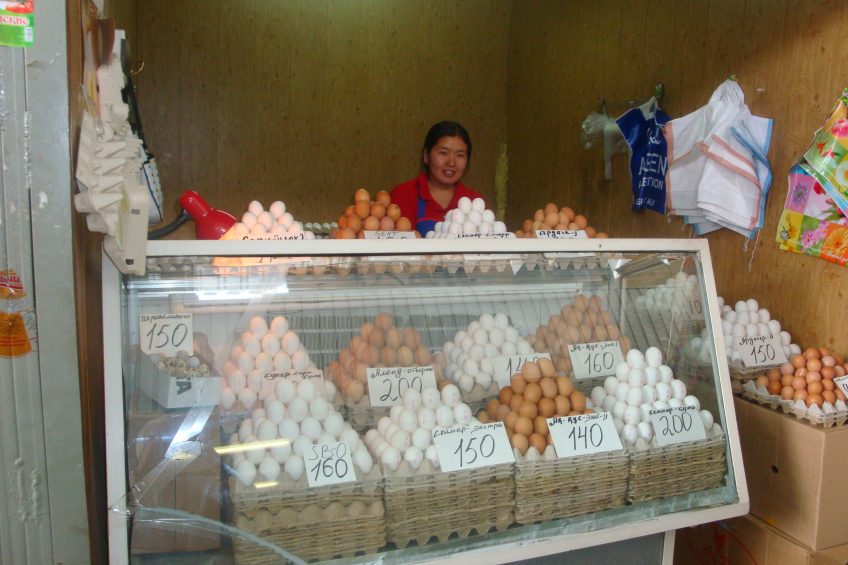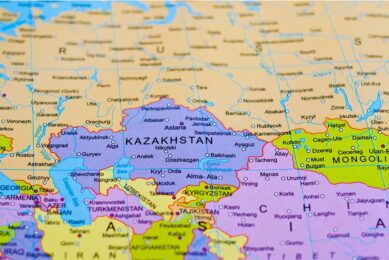Kazakhstan: Room for growth in the race to cut imports

Poultry production in the vast country of Kazakhstan is gradually on the rise after a major decrease since its independency in the early nineties. Modern technology and innovation are key ingredients however. The objective is to become fully independent from imports in the near future.
By Dr David Harrington , Alltech European Poultry Manager, Solutions Deployment Team
Kazakhstan is huge, almost six times larger than Europe’s largest poultry producer France but with a population of 15.5 million. Agricultural land occupies more than 220 million hectares, almost 70% of which consists of pasture. Its size and geographic location at the crossroads of Central Asia provide the country with the opportunity of diversified agribusiness development, but in the poultry sector there is work to do.
Photo: Leo Geilvoet
Kazakhstan’s market economy is growing fast, boosting agribusiness and farming. Today, cattle are the government’s priority sector, and as a result the largest share of subsidies is focused on increasing cattle herds and beef production.
Nevertheless, in an attempt to staunch the flow of cheap imports and take advantage of access to neighbouring markets, the Kazakh government continues to provide subsidies and beneficial credit terms to the poultry sector to encourage growth. Financial support includes an up to 45% subsidy for poultry feed production; in addition, grains from government stocks are frequently sold at below market rates. Beneficial credit terms are also available for the leasing of equipment.
Kazakh egg production has grown faster than broiler production, and has nearly reached the levels of before the break-up of the Soviet Union (Figure 1). As a result egg production has almost reached consumption level and Kazakhstan is becoming self-sufficient. Poultry is still a different story (Figure 2). Despite strong domestic demand, the government implemented a tariff-rate quota for poultry imports in 2010. This has reduced imports and has led to rising poultry prices.
Gradual recovery
Kazakhstan’s poultry production declined rapidly following the break-up of the Soviet Union, which brought about the removal of large-scale government subsidies and collapse of government-owned farms, or Sovkhozs. According to the Kazakhstan Statistics Agency, in 1990 the poultry population was nearly 60 million broilers; this number had collapsed to below 20 million by 2000. Since that time, there has been a gradual recovery and by October 2011, there were 36 million birds.
Kazakhstan’s poultry production declined rapidly following the break-up of the Soviet Union, which brought about the removal of large-scale government subsidies and collapse of government-owned farms, or Sovkhozs. According to the Kazakhstan Statistics Agency, in 1990 the poultry population was nearly 60 million broilers; this number had collapsed to below 20 million by 2000. Since that time, there has been a gradual recovery and by October 2011, there were 36 million birds.
Today, there are 39 poultry farms for egg production and 23 poultry farms for meat production in Kazakhstan. The latter include 14 farms which are breeding operations. Broiler meat production in Kazakhstan has expanded with bird numbers, and has risen from 65,000 tonnes in 2006 to an expected 120,000 tonnes in 2012. The government’s goal is to produce 140,000 tonnes by 2014.
New facilities
A programme of investment in high-tech projects aims to curb a dependency on imports and open the way to poultry exports. The first project was launched in December 2011 in the south of the country, a complex equipped with the latest technology to produce 4.8 thousand tonnes of poultry meat per year. The plant will have a full production cycle, from hatchery to waste processing. All in all, the government has approved the construction of six such facilities across the country with total production volume of about 40 thousand tonnes per year.
A programme of investment in high-tech projects aims to curb a dependency on imports and open the way to poultry exports. The first project was launched in December 2011 in the south of the country, a complex equipped with the latest technology to produce 4.8 thousand tonnes of poultry meat per year. The plant will have a full production cycle, from hatchery to waste processing. All in all, the government has approved the construction of six such facilities across the country with total production volume of about 40 thousand tonnes per year.
Domestic production now accounts for about half of all poultry consumed in Kazakhstan. However, much comes from backyard production and is consumed directly by households without entering conventional marketing channels. Therefore, poultry on sale in urban centres remains primarily imported. Domestically-produced broiler meat that does reach the market is typically sold as whole broilers, while imported products are almost entirely leg quarters. Domestic products are typically priced significantly higher than imported poultry.
Import restrictions
Beef continues to be the primary meat consumed in Kazakhstan, accounting for an estimated 39% of total consumption, followed by poultry with 21% and pork with 20%. Poultry consumption fell in 2008 and 2009 as a result of economic downturn and although it has recovered, import restrictions continue to limit the amount of poultry meat available to meet domestic demand.
Beef continues to be the primary meat consumed in Kazakhstan, accounting for an estimated 39% of total consumption, followed by poultry with 21% and pork with 20%. Poultry consumption fell in 2008 and 2009 as a result of economic downturn and although it has recovered, import restrictions continue to limit the amount of poultry meat available to meet domestic demand.
Poultry is by far the cheapest animal meat, with prices typically half of those of other meats. Kazakhstan currently imports around half of all poultry consumed, with over 90% coming from the United States in the form of chicken leg quarters via the ports of Lithuania and Latvia. In 2010, the Kazakhstan Customs Service reported imports from the United States at 105,000 tonnes, with a value of $83 million.
Imports have fallen somewhat in recent years, however, as a result of import barriers. As part of the Customs Union between Kazakhstan, Russia and Belarus, all member states established tariff-rate quotas for beef, pork and poultry starting in 2010. The quota for Kazakh poultry was set at 110,000 tonnes; imports had been as high as 150,000 tonnes in previous years. The 2011 quota was unchanged; 2012 figures have yet to be announced but a 30% reduction is believed to be planned.
Education is key
Alltech has been active in Kazakhstan for the past six years. The company is a member of the Poultry Union of Kazakhstan. Their aim is to contribute to identifying and solving problems in the industry. “Alltech will expand its presence here,” says Kazakhstan country manager Yulia Chaplinskaya. “As always, our focus is on education and innovation. Education is the key in Kazakhstan, where the lack of skilled workers hampers the poultry industry’s competitiveness in the face of imports. So we will present seminars, take part in exhibitions and we plan to visit poultry farms all over Kazakhstan. We will be proactive in inviting specialists and scientists from Russia, Ukraine and Belarus to provide permanent consultative support. We want to help the poultry industry gain autonomy, experience and market share.”
Alltech has been active in Kazakhstan for the past six years. The company is a member of the Poultry Union of Kazakhstan. Their aim is to contribute to identifying and solving problems in the industry. “Alltech will expand its presence here,” says Kazakhstan country manager Yulia Chaplinskaya. “As always, our focus is on education and innovation. Education is the key in Kazakhstan, where the lack of skilled workers hampers the poultry industry’s competitiveness in the face of imports. So we will present seminars, take part in exhibitions and we plan to visit poultry farms all over Kazakhstan. We will be proactive in inviting specialists and scientists from Russia, Ukraine and Belarus to provide permanent consultative support. We want to help the poultry industry gain autonomy, experience and market share.”
“With government support, over the last ten years, 56 poultry farms have been reconstructed and have entered operations. A further five are at the planning stage. Poultry meat production has tripled in that period, reaching 103,000 tonnes in 2011. The commercial poultry population has increased to 19.3 million head. We are heading towards optimised capacity in state-of-the art production facilities.
Over the same period, production volume of eggs on poultry farms has increased two-fold, standing at 2.4 billion today. Poultry and egg production increases have gone a long way to meeting consumer demands for these products in Kazakhstan. I think that the farms must obey the requirements of sanitary standards and to work according to veterinary laws and regulations of the poultry sector.
Poultry products are highly regarded by Kazakh consumers and compare favourably with other meats in terms of quality and price. Poultry consumption grows year in, year out. As for now, poultry exports are inexistent. Our goal is to reduce imports and to meet domestic demand through domestic production. We are certainly interested in foreign investment to help us boost production, decrease production costs and increase price competitiveness. We need to better manage the flow of poultry imports from Russia and Belarus that are close to their sell-by date. They flood our market at prices up to two times lower than domestically-produced poultry.”












 Beheer
Beheer WP Admin
WP Admin  Bewerk bericht
Bewerk bericht